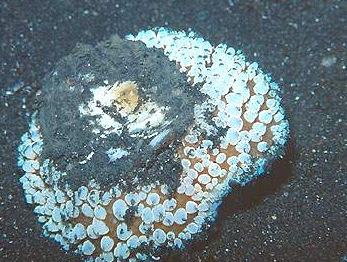
Umbraculum umbraculum
(Lightfoot, 1786)
Umbrella Slug
Not Reef Tank Suitable
Not Suitable for Fish-Only Tank
More
Let me first thank Mary Jane Adams for lending her expertise in the area of "slugs." She was extremely helpful with proofing all the applicable text used here and for providing some great photos.
To say the taxonomy where these creatures are involved is complex is an understatement. And because certain animals have different aspects, even though basically looking the same, it's necessary to subdivide them into applicable groups.
As you explore these attached groups, those characteristics will be described. From there, explore the species mentioned. You'll find many pretty species, simply shown for identification only, and almost all deserve to be left in the wild.
FYI: There are few in this overall Grouping that show up in the aquarium trade, with those not photosynthetic or requiring anything but gentle to moderate water.
Therefore, as noted in other areas of this Species Library, some species may contain suggested PAR levels and/or Water Motion (WM) levels.
As for water motion, I've decided to relate it to the visible intensity of water motion on that of a long tentacle anemone. No visible tentacle motion is '0,' whereas a slight movement of some tentacles is '1.' If all the tentacles are gently swaying in the current it is '2.' If all tentacles are moving fairly fast and bouncing into each other it is '3.' Should all tentacles be driven with such force they are extended in one direction or unable to sway back to their central position it's '4.'
You will see them as - PAR - XXX & WM - X. Hopefully you'll find this quite helpful.

